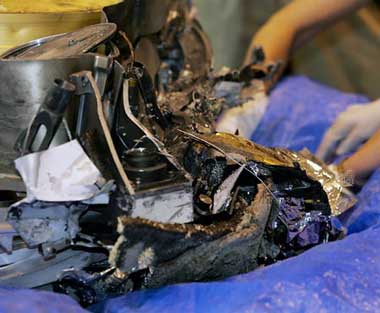 |
The remains of the Genesis capsule
are examined after it crashed in Dugway Proving Ground,
Utah. The space capsule, containing particles of solar
wind, was supposed to be snatched from the sky by
a helicopter before hitting the ground, but parachutes
that were to slow the fall failed to deploy.
Photo: AP Photo/Douglas C. Pizac |
 |
NASA's Jet Propulsion Lab's Amy Jurewicz,
left, and Don Sevilla, second from left, Johnson Space
Center's Judy Allton and Eileen Stansbery, right,
examine and pick pieces of dirt from the Genesis capsule.
Photo: AP Photo/Douglas C. Pizac |
SALT LAKE CITY -- NASA technicians have
begun picking through the wreckage of the Genesis space
capsule that crashed in the Utah desert Wednesday, with
hopes of recovering at least some of the solar wind samples
that the spacecraft collected over the past three years.
The technicians airlifted the damaged
capsule from its crash site to a storage building 30 miles
away Wednesday evening, approximately 11 hours after the
capsule came tumbling out of the sky without its parachutes
deployed. The capsule had embedded itself halfway in the
desert sand upon impact, requiring the recovery team to
dig it out first, NASA said Thursday.
"It was a purely manual operation,
with shovels, to lift it out of the ground and lift it
onto a tarp," said Genesis program scientist David
Lindstrom.
The Genesis capsule was to have deployed
two parachutes in succession during its descent from space
Wednesday morning. The parachutes would have slowed the
420-pound capsule down to just 8 mph, at which point a
helicopter would have snatched it out of the air and lowered
it safely to the ground. Instead, it shot into the ground
at an estimated 193 mph, stunning the helicopter pilots
and NASA officials who watched helplessly.
 An
inspection immediately following the crash revealed more
bad news for the Genesis team: The impact had torn open
both the capsule's outer hull and its inner science canister,
shattering the gold, diamond, sapphire and silicon solar
wind collectors inside and contaminating them with dust. An
inspection immediately following the crash revealed more
bad news for the Genesis team: The impact had torn open
both the capsule's outer hull and its inner science canister,
shattering the gold, diamond, sapphire and silicon solar
wind collectors inside and contaminating them with dust.
Scientists had hoped to study the charged
atoms that had embedded themselves in the collectors during
Genesis' three-year, $264 million mission in space. It
is unclear at this point whether they will still be able
to do that.
A photograph released by NASA showed large
metal chunks of the capsule laid out on tarps on the floor
of the storage building. Lindstrom said the recovery team
had cleaned dirt and other contaminants off the outside
of the science canister and had moved it to a clean room
for further study.
The canister had not been opened as of
noon, he said. But, he added, the technicians could see
that at least one of the more than 250 solar wind collectors
was still intact, raising hopes of salvaging at least
some of the mission.
Other collectors would probably be "dust,"
he said.
The technicians are expected to open the
canister sometime Thursday afternoon. Once all the pieces
of the collectors have been cataloged, they will be sent
to NASA's Johnson Space Center in Houston, where they
will be loaned to scientists for further study.
According to space agency policy, NASA
officials must set up an investigation board before Saturday
to begin examining the causes of Wednesday's crash.
Though the investigation is likely to
take months, some NASA officials speculate that a faulty
battery or electrical system is to blame for Genesis'
failure to deploy its parachutes.
The failure has raised questions about
the fate of other NASA sample-collecting missions. Most
notably, the Stardust space capsule containing particles
spewed from a comet is scheduled to return to Earth by
parachute in January 2006.
Though Stardust's parachute system is
not an exact replica of Genesis' system, the two spacecraft
do share some common design elements. Given this, the
outlook may be bleak for Stardust if the failure lies
in the shared components.
"For Stardust, the die is cast. It's
already in flight and not due back until 2006," said
Chris Jones, director for solar system exploration at
the Jet Propulsion Laboratory, which manages the Stardust
mission for NASA.
Still, he offered some hope in the event
that Genesis' problems were not purely mechanical. What
is learned from the Genesis investigation may help NASA
prepare Stardust for entry into the atmosphere, he said.
Another mission developed by the European
Space Agency is scheduled to parachute down to the surface
of Saturn's moon Titan in January 2005. But that mission,
dubbed Huygens, uses a much different parachute system
and is expected to hit the ground by design, said Jones.
|